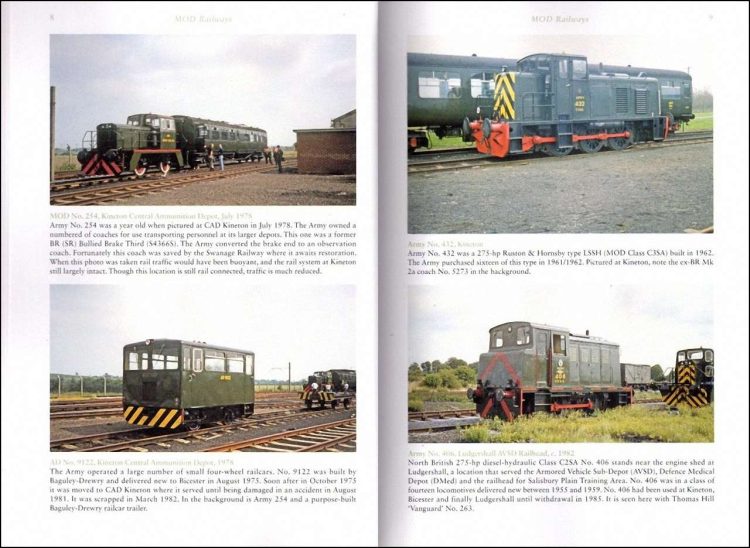Published in November 2021 and written by Michael Hitchen, this softcover book comes in the usual Amberley format of around 234 mm x 165 mm with 96 pages and 180 colour and black-and-white photographs. It has a published price of £15.99, although at the time of writing it is out of stock from Amberley Publishing but can be purchased from Amazon for £11.19.
The Introduction provides a brief background to the many different types of MOD establishments that had railways systems, both standard and narrow gauge. The titles of the establishments abound in acronyms, such as RNAD, MU, ROF, DM, and CVD, some of which the author has expanded whilst others are unexplained.
Many of the establishments are in obscure locations, such as West Moors, Trecwn, Ernesettle, Dean Hill, and Bedenham, but in many cases, there is no clue given as to where they are, or even what in county they are situated. At a minimum, an outline map would have enhanced the usefulness of the volume.
After a two-page Introduction, there are no chapters as the remainder of the book is devoted to photographs from 16 of the many MOD establishments that had railway systems.
The book starts off with a good assortment, with five photos from Bicester Ordnance Depot, four from Kineton Central Ammunition Depot, followed by others from Ludgershall Railhead, Marchwood Military Port, RAF Carlisle, RAF Leuchars, Warminster Central Vehicle Depot, and others. But then the tour of different sites stops, as the next 42 photos are of RAF Chilmark, and no less than 88 from RNAD Dean Hill.
The omission of photos from many other sites, such as Longmoor, Shoeburyness, or the erstwhile Shropshire and Montgomeryshire Railway let the book down. In the introduction, the author states he has attempted to include a snapshot of a few systems still in existence, but I am sure any buyer of the book will expect more than a snapshot of just a few systems.
The photos themselves show a good range of the types of locomotives and wagons in use at these establishments, and highlight just how tidy and well-kept they are compared with today's main line railways.
It would have been useful to have an index, and instead of the book's title being used for the heading on each page, it would have been better to include the location of the site.
Although the locations of the photos are included in each caption and the caption text is printed in black, the locations are printed in very pale green which in some light becomes almost invisible.
The captions on these pages exemplify the lack of clarity by using pale green for the locations. Also, the caption to the lower-right photo includes one of the many acronyms found throughout the book, in this case AVSD, which stands for Armoured Vehicle Sub-Depot.

The use of acronyms is again shown in the pages below, with the lower-left caption referring to a Saxon APC, which one assumes to be Armoured Personnel Carrier, while the lower-right refers to four CVR(T)s, which stands for Combat Vehicle Reconnaissance (Tracked) but the definition was only determined after searching the Internet.
Although the captions for three of these photos state OESD East Riggs, it is only by reading one of the captions that we find out that OESD stands for Ordnance Explosive Storage Depot; the locomotives seem to have been specially designed for their roles at this site.
Among the many photos from RAF Chilmark are a wide range of wagons, such as those shown here.
Among the more interesting photos in the book are those showing Salisbury Plain, which is home to some very unusual railways used in connection with target practice, such as those shown here.
In summary, this book has a good range of photos showing locomotives, rolling stock and infrastructure, but is let down by only covering a limited number of depots, with nearly half from a single depot, Dean Hall, and a quarter from another, RAF Chilmark. Although the Introduction hints at there being many depots of various kinds throughout the country, only a very few are included. As many of the locations are by their very nature sited well away from centres of population, a guide to their approximate locations should have been included. For the same reason, a lack of detailed railway layout maps is a serious omission. Will be of interest to those keen to see what sort of locomotives and wagons are behind the security fencing at these secretive establishments.
The book is available to purchase from Amazon for around £11.19.
We would like to thank Amberley Publishing for providing RailAdvent with a copy of the book for review.